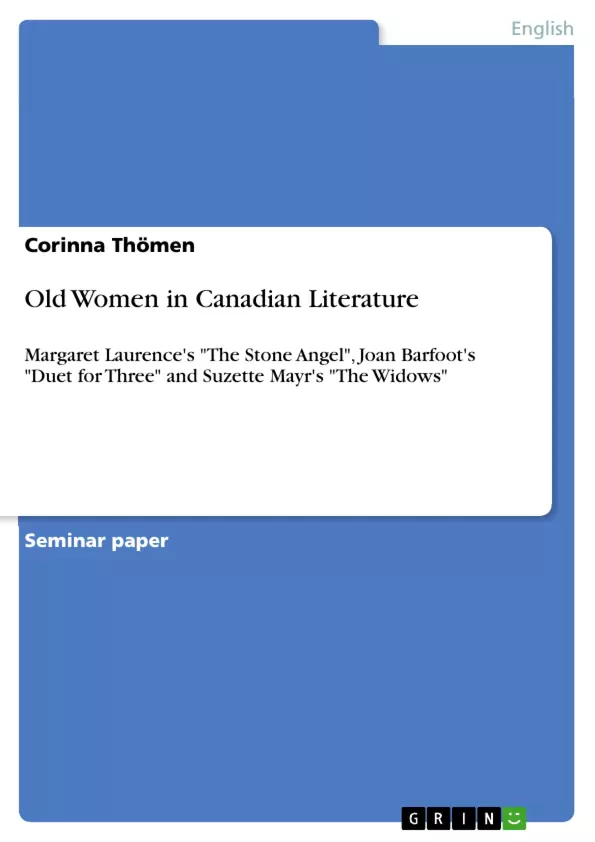Everyone of us is concerned with the process of aging. As soon as we are born, our body starts to grow older and with the years it becomes visibly more and more. Aging is the natural course of life but in our society it often seems to be an uncomfortable subject to talk about.
Although the situation of the elderly has improved throughout the last years, older people are often neglected and marginalized by society. They are often associated with negative images like being helpless, rigid and useless.
The study of aging is very complex and can be examined from many perspectives, for example from a biological, a sociological, or a psychological point of view.
This paper focuses on aging in literature, especially in the writings of Canadian women authors, in which old age is a relatively new subject.
The aim of this paper is to point out how Canadian women writers deal with the topic of old age, especially that of women, and what kind of image about old age they want to transmit through their stories. Are they depicting old women in stereotypical ways or do they try to reveal and change those stereotypes?
The novels that will be discussed here, are Margaret Laurence’s The Stone Angel (1964), Joan Barfoot’s Duet for Three (1985), and The Widows (1998) by Suzette Mayr.
Before analyzing different aspects of aging in these novels, it will be useful to have a look at the social construction of age.
Afterwards, I will explore different issues of aging that play important roles in the novels and also in our society.
Starting with the aspect of physical aging and the impact it has on the different female characters, the second point will analyze the relationships of grandmothers and granddaughters.
Furthermore, it will be interesting to see how the authors deal with the widespread negative images of nursing homes and the fear that is often associated with those places.
Finally, this paper will explore the representation of sexuality in the novels. How are older people depicted in terms of sexual relationships? Are they really as asexual as many people think or is this one of many misperceptions about old people?
Inhaltsverzeichnis (Table of Contents)
- 1. INTRODUCTION
- 2. THE SOCIAL CONSTRUCTION OF AGE
- 3. OLD WOMEN IN CANADIAN LITERATURE: THE STONE ANGEL, DUET FOR THREE AND THE WIDOWS
- 3.1 THE AGING BODY
- 3.2 THE RELATIONSHIP OF GRANDMOTHERS AND GRANDDAUGHTERS
- 3.3 THE FEAR OF NURSING HOMES
- 3.4 OLD WOMEN AND SEXUALITY
- 4. CONCLUSION
- 5. LITERATURE
Zielsetzung und Themenschwerpunkte (Objectives and Key Themes)
This paper examines how Canadian women writers portray old age, particularly the experiences of older women, in their novels. It explores the portrayal of aging in Margaret Laurence's "The Stone Angel," Joan Barfoot's "Duet for Three," and Suzette Mayr's "The Widows," analyzing how these authors challenge or perpetuate stereotypes surrounding aging women.
- The social construction of age and its impact on perceptions of older people.
- The physical changes associated with aging and their representation in literature.
- The complex relationships between grandmothers and granddaughters in the novels.
- The societal fears and anxieties surrounding nursing homes and their portrayal in the texts.
- The representation of sexuality in older characters and its potential for challenging societal norms.
Zusammenfassung der Kapitel (Chapter Summaries)
The introduction establishes the context for the study, highlighting the increasing visibility of older people in society and the continued marginalization they face. The paper then delves into the social construction of age, discussing how aging is often perceived as a negative phenomenon, particularly for women.
Chapter 3 explores the portrayal of aging in three Canadian novels: "The Stone Angel" by Margaret Laurence, "Duet for Three" by Joan Barfoot, and "The Widows" by Suzette Mayr. The chapter examines how these authors explore the physical changes associated with aging, the complexities of grandmother-granddaughter relationships, the fear of nursing homes, and the representation of sexuality in older characters.
The paper aims to demonstrate how these novels offer nuanced and multifaceted perspectives on the lived experiences of older women in Canadian society.
Schlüsselwörter (Keywords)
The primary keywords and focus topics of this paper include aging, Canadian women writers, Margaret Laurence, Joan Barfoot, Suzette Mayr, "The Stone Angel," "Duet for Three," "The Widows," social construction of age, stereotypes, grandmothers, granddaughters, nursing homes, sexuality, and representation. These terms encapsulate the core themes and concepts explored in the analysis of these novels.
- Quote paper
- Corinna Thömen (Author), 2005, Old Women in Canadian Literature, Munich, GRIN Verlag, https://www.grin.com/document/74435



